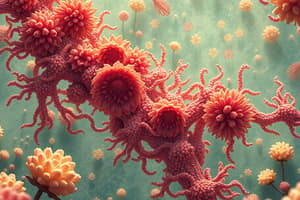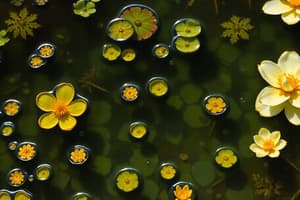Podcast
Questions and Answers
What characterizes the lag phase in bacterial growth?
What characterizes the lag phase in bacterial growth?
- The population of bacteria decreases significantly.
- Bacteria are acclimating to the new medium. (correct)
- Rapid bacterial reproduction begins immediately.
- Bacteria enter a death phase.
What phase follows the lag phase in the bacterial growth curve?
What phase follows the lag phase in the bacterial growth curve?
- Log phase (correct)
- Decline phase
- Stationary phase
- Death phase
Which description best defines catabolism in bacterial metabolism?
Which description best defines catabolism in bacterial metabolism?
- It only occurs during the stationary phase of growth.
- It involves assembling small molecules into larger ones.
- It results in energy-yielding degradation of macromolecules. (correct)
- It is the equivalent of photosynthesis in bacteria.
Which of the following factors does NOT typically affect enzyme activity in bacteria?
Which of the following factors does NOT typically affect enzyme activity in bacteria?
What happens to enzyme activity when temperature exceeds the optimum level?
What happens to enzyme activity when temperature exceeds the optimum level?
In microbial oxidation, what occurs during the process?
In microbial oxidation, what occurs during the process?
What is the role of bacteria in biogeochemical processes?
What is the role of bacteria in biogeochemical processes?
What occurs during the reduction process in microbial metabolism?
What occurs during the reduction process in microbial metabolism?
What is one characteristic of algae?
What is one characteristic of algae?
Which of the following is NOT a class of unicellular algae?
Which of the following is NOT a class of unicellular algae?
What nutrient is primarily required by algae for photosynthesis?
What nutrient is primarily required by algae for photosynthesis?
How do some algae obtain energy in the absence of light?
How do some algae obtain energy in the absence of light?
Which statement about fungi is true?
Which statement about fungi is true?
Protozoa are classified based on which of the following criteria?
Protozoa are classified based on which of the following criteria?
What structural characteristic is common among fungi?
What structural characteristic is common among fungi?
Which type of movement is exhibited by protozoa?
Which type of movement is exhibited by protozoa?
What is the primary form of nitrogen absorbed by plants from the soil?
What is the primary form of nitrogen absorbed by plants from the soil?
Which bacteria are primarily responsible for the process of nitrification?
Which bacteria are primarily responsible for the process of nitrification?
What occurs during denitrification?
What occurs during denitrification?
What is a potential consequence of nitrate functioning as an electron receptor in microbial processes?
What is a potential consequence of nitrate functioning as an electron receptor in microbial processes?
Which statement is true about nitrification mechanisms?
Which statement is true about nitrification mechanisms?
In terms of energy yield, how does the reduction of nitrate to nitrogen gas compare to other reductions?
In terms of energy yield, how does the reduction of nitrate to nitrogen gas compare to other reductions?
What is the essential role of nitrification in the ecosystem?
What is the essential role of nitrification in the ecosystem?
Which of the following statements is false about bacteria involved in nitrification?
Which of the following statements is false about bacteria involved in nitrification?
What role do algae play in aquatic environments?
What role do algae play in aquatic environments?
Which statement about bacteria at the air-water interface is accurate?
Which statement about bacteria at the air-water interface is accurate?
What is a significant concern regarding bacteria at the air-water interface?
What is a significant concern regarding bacteria at the air-water interface?
What process do microorganisms primarily facilitate in water?
What process do microorganisms primarily facilitate in water?
How do microorganisms contribute to waste treatment?
How do microorganisms contribute to waste treatment?
Which characteristic distinguishes bacteria at the air-water interface from those found in the body of water?
Which characteristic distinguishes bacteria at the air-water interface from those found in the body of water?
What types of food do bacteria accumulate at the air-water interface?
What types of food do bacteria accumulate at the air-water interface?
In what way do microorganisms contribute to the historical association with waterborne diseases?
In what way do microorganisms contribute to the historical association with waterborne diseases?
What is the significance of carbon in microorganisms?
What is the significance of carbon in microorganisms?
Which process involves changes in the oxidation state of carbon in microorganisms?
Which process involves changes in the oxidation state of carbon in microorganisms?
What impact can certain organic pollutants have on microbial populations?
What impact can certain organic pollutants have on microbial populations?
What is one vital process described in the nitrogen cycle?
What is one vital process described in the nitrogen cycle?
Which organisms are known for their ability to fix atmospheric nitrogen?
Which organisms are known for their ability to fix atmospheric nitrogen?
Which of the following processes is NOT a component of the nitrogen cycle?
Which of the following processes is NOT a component of the nitrogen cycle?
How do microorganisms facilitate the nitrogen cycle?
How do microorganisms facilitate the nitrogen cycle?
What type of microorganisms can fix nitrogen in aquatic environments?
What type of microorganisms can fix nitrogen in aquatic environments?
Flashcards are hidden until you start studying
Study Notes
Aquatic Biochemical Processes
- Microorganisms act as catalysts in water and soil for chemical processes
- Chemical reactions in water often involve organic matter and oxidation-reduction processes, with bacteria as key players.
- Algae are primary producers of organic matter in water.
- Microorganisms are crucial for sediment and mineral formation, playing a major role in wastewater treatment.
- Microorganisms are associated with waterborne diseases, highlighting the importance of water purification.
Aquatic Microorganisms and Interfaces
- Aquatic microorganisms often thrive at interfaces, particularly on solids suspended in water or sediments.
- Bacteria at the air-water interface have a hydrophobic cell character, distinct from those within the water body.
- Bacteria at the air-water interface can be incorporated into aerosol water droplets and spread through wind when bubbles burst.
- This raises concerns about sewage treatment plants as potential vectors for spreading disease-causing microorganisms.
Algae
- Algae are generally microscopic organisms that rely on inorganic nutrients and photosynthesize to produce organic matter.
- Four main classes of unicellular algae:
- Chrysophyta (yellow-green or golden-brown)
- Chlorophyta (green algae)
- Pyrrophyta (dinoflagellates)
- Euglenophyta
- Algae require various nutrients like carbon, nitrogen, phosphorus, sulfur, and trace elements for growth.
- Their role in aquatic systems is vital, producing biomass and forming the base of food webs.
- In the absence of light, algae can metabolize organic matter or use stored starches or oils for energy.
Fungi
- Fungi are non-photosynthetic, often filamentous organisms with diverse morphology.
- They are aerobic and can thrive in acidic media and high concentrations of heavy metal ions.
- Fungi play a critical role in the environment, particularly in the breakdown of cellulose in plant materials.
Protozoa
- Protozoa are classified based on morphology, locomotion, chloroplasts, shells, cyst formation, and spore formation.
- They exhibit diverse shapes and fascinating movement under a microscope.
- Locomotion can be achieved using flagella, cilia, or pseudopodia.
Kinetics of Bacterial Growth
- The population curve for a bacterial culture shows population size as a function of time in a growth culture.
- Four phases of bacterial growth:
- Lag phase: minimal bacterial reproduction, as they acclimate to the new medium.
- Log phase: rapid exponential growth.
- Stationary phase: growth rate slows due to limited resources.
- Death phase: population declines due to nutrient depletion and waste accumulation.
Bacterial Metabolism
- Bacteria obtain energy and raw materials for metabolism and reproduction through chemical reactions.
- Catabolism: breaks down macromolecules into smaller molecules, releasing energy.
- Anabolism: builds large molecules from smaller ones, requiring energy.
- Bacteria are essential for biogeochemical processes, involving elemental cycles of nitrogen, carbon, sulfur, and mineral deposition.
Factors Affecting Bacterial Metabolism
- Substrate concentration: enzyme activity increases linearly up to a saturation point, then levels off.
- Temperature: enzyme activity increases with temperature, reaching a maximum at the optimum temperature, then sharply declines due to denaturation.
- pH: enzymes have an optimal pH around neutrality, with denaturation occurring at extremes.
Microbial Oxidation and Reduction
- Microbial oxidation and reduction are metabolic processes where bacteria gain energy through electron transfer in redox reactions.
- Oxidation: bacteria donate electrons, releasing energy.
- Reduction: bacteria gain electrons, using them in metabolic processes.
Microbial Transformations of Carbon
- Carbon is a critical element for microorganisms, constituting a significant portion of their dry mass.
- Many metabolic processes involve changes in carbon's oxidation state.
- Microbial carbon transformations have environmental implications, like energy release and oxygen consumption during decomposition.
Biodegradation of Organic Matter
- Organic matter biodegradation in aquatic and terrestrial environments is a crucial process.
- Some organic pollutants can be biocidal, harming beneficial fungi and bacteria.
- Organic matter biodegradation by microorganisms occurs through stepwise, microbially catalyzed reactions.
Microbial Transformations of Nitrogen
- The nitrogen cycle describes the dynamic interchange of nitrogen between the atmosphere, organic matter, and inorganic compounds.
- Key biochemical transformations in the nitrogen cycle:
- Nitrogen fixation: conversion of atmospheric nitrogen to a usable form.
- Nitrification: oxidation of ammonium to nitrate.
- Nitrate reduction: reduction of nitrate to lower oxidation states.
- Denitrification: reduction of nitrate to nitrogen gas.
- Microorganisms play a crucial role in each step of the nitrogen cycle, facilitating nitrogen conversion.
Nitrogen Fixation
- Nitrogen fixation involves binding atmospheric nitrogen into a chemically combined form.
- Certain aquatic microorganisms, like photosynthetic bacteria and cyanobacteria, can fix nitrogen.
- Most fixed nitrogen in water bodies comes from external sources, such as fertilizers.
- Rhizobium bacteria found in the root nodules of leguminous plants form a symbiotic relationship, converting atmospheric nitrogen into a usable form for the plants.
Nitrification
- Nitrification is a process converting ammonium to nitrate, crucial for plant growth as nitrate is the preferred nitrogen form.
- Two groups of bacteria involved:
- Nitrosomonas: oxidizes ammonium to nitrite.
- Nitrobacter: oxidizes nitrite to nitrate.
- Both are obligate aerobes, requiring molecular oxygen for their metabolic processes.
Nitrate Reduction
- Refers to microbial processes reducing nitrogen compounds to lower oxidation states.
- When free oxygen is limited, some bacteria use nitrate as an electron acceptor.
- Sodium nitrate can act as an emergency oxygen source in oxygen-deficient sewage lagoons.
- Nitrate reduction can produce nitrite, which can reach toxic levels and inhibit microbial growth.
Denitrification
- Denitrification is a nitrate reduction process that produces nitrogen gas.
- It yields less energy than other reduction processes.
- Denitrification allows fixed nitrogen to return to the atmosphere, completing the nitrogen cycle.
Studying That Suits You
Use AI to generate personalized quizzes and flashcards to suit your learning preferences.




